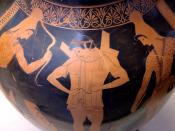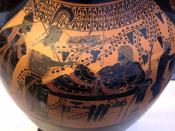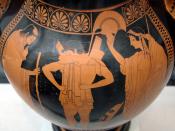Euthymides' Three Revelers is a Greek red-figure vase painting which dates back to about 510 BC. It was found in an Etruscan tomb in Vulci, Italy, where it had probably been imported from Athens. This is proof of the virtuosity of ancient Greek artists, and is quite ironic since the Greeks learned vase painting from the Corinthians.
The earliest ancient Greek vase paintings were created using the black-figure technique. This involved using a clay-based slip to draw on the figures and later adding details by incising them into the clay of the vase. Through a process of firing the vase multiple times, the slip would turn black; the silhouetted painted figures contrasted with the natural brown-orange color of the vases. Exekias' Achilles and Ajax Playing Dice (c. 525-520 BC) is a well-known example of black-figure vase painting. The background of the scene is the natural clay color and all the painted figures are blackened slip with incised details.
In Exekias' painting, there are also details in white on the capes of the two men.
The red-figure technique was developed shortly after and is the opposite of black-figure. The background around the figures was painted with slip, leaving them to be detailed with black against the natural color of the vase. This allowed the artist to paint with higher detail since no incisions were necessary.
The painting of the Three Revelers is found on a vase used for storing wine called an amphora, so it is appropriate that the three men are celebrating (and indeed reveling) in their drunkenness. The man on the left hasn't even considered putting down his cup before joining the fun. The scene probably takes place during or after a symposium- a combination drinking party, orgy, and debate. Symposiums were held and attended by aristocratic Greek...


